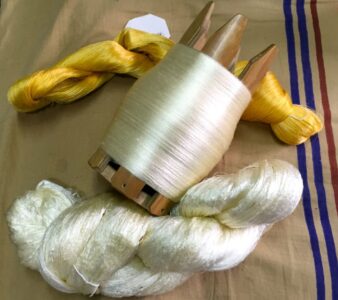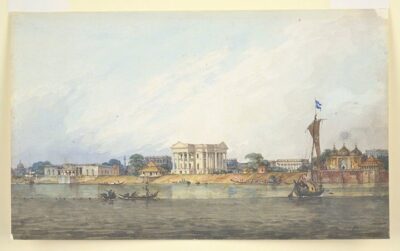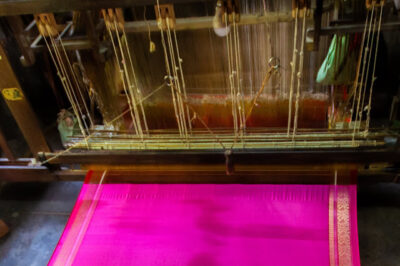Introduction

Murshidabad silk, famously called the “queen of weaving” or “Queen’s weaving,” stands as a witness to the rich cultural heritage of Bengal, being an integral part of the journey itself. Passed through generations, this craftsmanship is renowned for its premium quality and its importance in the foreign trade market, enriching the Bengal economy. They stand as living proof of the cultural blend between trend and tradition and continue to capture attention with their golden threads. To understand its relevance, it is essential to understand the background story and the modern situation of this craftsmanship.
Murshidabad: The Hub of Bengal Silk

A transition was observed when Bengal silk production was divided into three major hubs of silk: Murshidabad silk, Rajshahi silk, and Malda silk. Currently, being the second-largest silk-producing district in West Bengal and the third largest in India, Murshidabad has its share of stories. The region, due to its strategic positioning in the Bengal landscape, became one of the major trade points for the East India Company.
The history of settlement can be traced back to the early eighteenth century, during the transition from Mughal rule to colonization, when the Nawab of Bengal, Murshid Quli Khan, shifted his capital from Dacca (present-day capital of Bangladesh) to a region situated near the Bhagirathi River, one of the important branches of the Ganges River. Gaining the name of the Nawab himself, this region was called Murshidabad.
George C.M. Birdwood mentions that the city of Murshidabad is still famous globally for its “golden brocades or kincabs.” This, therefore, highlights the importance of Murshidabad as a silk manufacturing hub. Besides being the main centre of silk manufacturing, it also widely produced muslin, jamdani, and Baluchari Butidar silk sarees, reflecting both an economic and cultural heritage of the Bengal trade industry.
The Historical Legacy
During the early seventeenth century, the foreign traders became attracted to Bengal silk (here, Murshidabad silk). Around the period between 1650 and 1660, the East India Company established a “Kuthi” in Kasimbazar (present-day Cossimbazar) in the Murshidabad region. The term “kuthi” indicates a property where business was conducted through dealings and networking, enabling the British traders to establish a monopoly over the trading industry. Following this trend, other European merchants, such as the Dutch, Portuguese, and French, also established their kuthi in Kasimbazar. The main objective of establishing the Kuthi was to export the Murshidabad Silk to the European countries to gain profits.

Soon, the Murshidabad Silk gained recognition, both as a national and an international brand, due to the colonial marketing. The craftsmanship saw its spread in the South Indian region, such as the Mysore state. Tipu Sultan, the ruler of Mysore, sent an expert to the hub of silk production to understand the mastery behind the process. Inspired by this, the silk industry also saw a boost in production in the Mysore region.
After the defeat of Siraj-ud-Daulah, due to the betrayal of Mir Zafar, in the Battle of Plassey, the East India Company started exporting raw material from Murshidabad to Britain, resulting in the decline of the Bengal silk industry. With the first victory of the British East India Company in Bengal, the Murshidabad silk production saw destruction as the factories were closed in 1883 due to great economic losses.
Weaving the Threads: The Process
The production of silk as a fiber is done through sericulture. The silk threads, made from cocoons of the silkworm, require at least five to ten cocoons to make one 300 m thread. The silkworms are reared, feeding on mulberry leaves, giving the term “mulberry silk.” Once the silkworms reach one month, they start making the cocoons, with two days to weave around their body. One can assume the quality of the silk through the colour of the cocoons. With the bright yellow colour, a premium quality silk can be expected. Upon completion, the cocoons are plucked up and kept in the sun for one day, which makes the caterpillar die inside the cocoon.

The silk cocoons are boiled in water for approximately two hours, making the cocoons tender. With the coming of one single thread, it is fed into the machine to extract the amount of silk thread required. After getting extracted, these threads are then coloured and rolled up into bobbins, ultimately used for the weaving machine to make the Murshidabad Silk Saree.
With the production of silk fibers, they are sent for manufacturing on a loom. One of the popular looms is called the Pit Loom. These sarees are called handloom sarees, as they are woven by hand on a loom, taking a week to weave. Before weaving, the silk yarn is prepared in yarn sheets by rolling it on an iron rod, and the strands of the silk threads are passed through various holes in the loom. These threads are then passed through the punch cards, creating the unique designs on the silk saree. The weaver, then, presses the pedal of the loom and pulls the knob to create a mesh of the silk threads. To complete the entire manufacturing process, a total week is expected.
Themes of the print

The Murshidabad silk sarees offer a variety of intricate designs, with the cultural blending of both traditional and contemporary trending styles. The lightweight nature of these sarees makes them easy to carry, adding a touch of sophistication and luxury. The draping feature makes them unique, along with various forms of designs, either hand-painted or using block prints. These include floral patterns, paisleys, and the current favourite, geometric shapes and patterns. The hand-painted sarees are mostly inspired by the themes of nature, mythology, and folklore.
Current Situation
With the degradation of silkworm species and the decline in sericulture, the production of Murshidabad silk sarees is facing tragic losses. With history repeating itself, the administrative forces are seen to be the main reason for such failure. Mulberry production came to an end with the rising influence of climate change and natural calamities, such as drought and floods. Due to a lack of socio-economic benefits and less encouragement, the poor farmers are now forced to either shorten their silk production or fully migrate to urban areas for better livelihoods.

However, with government initiatives for supporting the handloom industries, an attempt can be made to restore the forgotten legacy. As Murshidabad continues to be the hub for important silk-weaving clusters for the production of fine silk sarees, the certifications and GI tags give hope for the longevity of this industry. In May 2023, for instance, the West Bengal National University of Juridical Sciences (WBNUJS) applied for a GI Tag on Murshidabad silk within the state. With the emerging concern for sustainability and appreciation for traditions, products such as Baluchari and Gorood continue to be trending from the looms of Murshidabad Silk. Other products, besides sarees, include sherwanis, styled for men.
Conclusion
Handloom, being the sustainable and traditional way for fabric production in India, forms the backbone of the rural economy, besides agriculture. The silks from Murshidabad, being one of the well-known handloom products, stand as a testimony to the growing economic prosperity of the Indian economy and its transition from the ancient to the modern period. Though believed to be on the verge of decline, silk production can be restored through the strategic development of these industries, just as it stood out against the atrocities imposed by colonial traders during the modern period, respectively.
References
https://en.wikipedia.org/wiki/Murshidabad_silk
https://www.shoestringtravel.in/2019/11/murshidabad-silk-saree-story-of-silk-weaving.html
https://www.parinita.co.in/pages/murshidabad-silks
https://www.anartline.com/index.php?route=bringblog/blog&blog_id=murshidabad-silk-making




